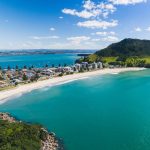In 1994, State Owned Enterprise Transpower became owner of the national grid, which connects power generating stations to local power companies throughout NZ.
Transpower wanted to upgrade its existing high-voltage line which went through Maungatapu, across Tauranga harbour on a large pylon in the middle of the estuary, and on to the Matapihi sub-station to supply power to the Mount and Papamoa.
“Consultation”
The original
To add insult to injury, a ‘Mid Line Proclamation’ was declared in 1976 that again took a large swathe of Maori Land without any consultation. The ‘Mid Line Proclamation’ went across Maori owned land in Kaitemako Road, over two marae, across further Maori land at Maungatawa, across the estuary and into the Matapihi sub-station.
The consultation document (environmental impact report) that formed part of that process was supplied to Federated Farmers, the Country Womens’ Institute and the Councils, among others. Again, no attempt was made to engage the Maori landowners who were pretty much the only parties to be seriously affected.
Thankfully this ‘Mid Line Proclamation’ in its entirety was never exercised, but neither has the Maori land that was taken been returned to its rightful owners.
Broken promises and hideous solutions
In 1995 Transpower, after considerable pressure, installed what is now called its ‘B Line’ which operates in parallel with the original ‘A Line’, through Maungatapu alongside the highway and across Maungatapu bridge in accordance with an agreement with the local community.
At that time Transpower gave an assurance that as soon as the B Line was constructed, the offending
It still traverses the centre of the rugby fields at Ngāti He’s Te Ariki Park. Currently the poles in Te Ariki Park, and the tower in the harbour are in grave danger of collapse due to erosion and corrosion.
Transpower now for a number of reasons, allegedly technical, does not want to attach this new line to the Maungatapu bridge, but instead use a financially much cheaper option of a single span of 3 lines between what equates to an 11-storey pole on the Maungatapu foreshore, and a 14-storey pole close to the foreshore on the Matapihi side of the bridge.
High Voltage Lines in Urban Areas This latest proposal from Transpower is of major concern to the Maungatapu marae, and the people of Maungatapu, and indeed all of Tauranga’s residents’ as it will significantly and adversely affect one of Tauranga’s more breathtaking coastal scenes enjoyed by many thousands of people travelling daily through this area.
The proposed lines and their super poles either side of the harbour have no place in this location, either culturally or environmentally, and will be a continued affront to the people of Ngāti He and the Maungatapu Marae.
Any alternatives, such as attaching the line to the bridge as originally was assured, and thence subsequently included in the Tauranga Moana Management Plan, have been set to one side.
Come on Transpower – do the right thing!
As a typical company, though Government-owned, Transpower seeks to externalise as many costs as is possible.
The proposed line to be strung across the estuary has a high environmental and cultural cost for the people of Maungatapu. The line should be attached to the Maungatapu Bridge as was the previous rebuild. This time it will undoubtedly cost more.
However, that cost should be borne by Transpower and all electricity users, not loaded on to the people of Maungatapu, who do not benefit directly from the rebuild, but are expected to shoulder a significant dip in their cultural capital, amenity and outlook.
It is not reasonable because you are big and powerful to take amenity and cultural value from others, on the grounds that it is cheaper (and your bottom line looks healthier), when an alternative is available. It may cost more, but attaching the cable to the Maungatapu Bridge is the right thing to do. It will also make the pylons on both sides much shorter and less intrusive.
The decision by the Councils is being appealed by the Tauranga Environmental Protection Society to the Environment Court.
By Mary Dillon QSM Long serving Councillor 1989-2007 – “I write for this magazine in the interests of the local community.”




































































